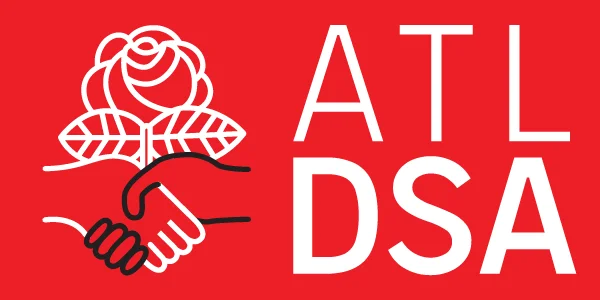

Ballad of an America: What does Paul Robeson's Life Teach Us?


Atlanta DSA stands in solidarity with Atlanta’s Asian-American community
The Atlanta Democratic Socialists of America (ATL DSA) stands in unity and solidarity with the Asian-American community in Atlanta, Georgia, and across the United States as we collectively process a horrific hate crime that targeted Asian women, killing 8 people.
Our first thoughts turn to the victims, their families and their communities. Many people, including our comrades in ATL DSA, are experiencing intense anger and pain in the wake of another racist mass shooting event. This spree shooter specifically targeted women, highlighting the particular gendered racism that Asian women face in the United States. In his own words, the shooter targeted businesses which he believed were sites of sex work. ATL DSA stands with Asian women, who face a particular gendered racism in the United States. We stand with sex workers, an unjustly criminalized group vulnerable to violence. We stand with Asian sex workers who are often victims of racialized sexual violence resulting from patriarchy and white supremacy. Race, gender, and class in America intersect in ways that render poor and unassimilated Asian Americans invisible and thus especially vulnerable to violence like the murders that were perpetrated on March 16.
Moreover, we know that this horrific event did not take place in a vacuum. Over the last year, acts of racist violence against Asian Americans have increased significantly, a direct result of the jingoistic rhetoric about China and the COVID-19 virus propagated by politicians on both sides of the aisle and furthered by corporate media outlets. During the 2020 presidential election, both Trump and Biden jockeyed to be “tougher on China,” as the ruling class egged on a new Cold War with China and continues to do so now. In any conflict between China and the U.S. or their proxies, it is the working class that suffers, abroad and at home. We must be vigilant in counteracting propagandic narratives that would lead us to believe otherwise. Yesterday’s killings are the latest expression of a long history of anti-Asian racism and discrimination that stretches back hundreds of years in the U.S.
The simple fact is yesterday’s murders did not need to happen. We must reject the anti-China and anti-Asian rhetoric that inundates American society, and we must fight to end the racialized misogyny that demonizes and oppresses sex workers. We denounce anti-Asian and Sinophobic rhetoric in all its forms, and we oppose those who wish to perpetuate conflict with China. We stand in solidarity with sex workers and oppose efforts to increase policing or expand the carceral state as a solution to this violence, as we know this would only result in further oppression and harm towards those affected.
We stand in solidarity with communities most impacted by this attack and are prepared to respond to calls for support. We are listening to our comrades, our local Asian-American community groups and their leaders, to best understand how to act in solidarity, and we will amplify any ways that the broader community can demonstrate their support as well.
Also see the DSA National Political Committee’s statement for more info.


On Sexual Harassment Allegations Against Governor Andrew Cuomo
Sexual harassment is never ok, never funny, and never just a misunderstanding. A report by the Equal Employment Opportunity Commission in 2016 stated that about 60% of women have experienced some sort of sexual harassment in the workplace. The accounts by three women, so far, of sexual misconduct and harassment by Governor Cuomo are familiar to almost any woman who has interacted with men in a professional or social environment.
Governor Cuomo has been the headline of several scandals in the last months. His personal disregard for women also manifests in his austerity politics as a governor, where he has cut funding from programs that disproportionately impact working class women. After cutting Medicaid funds during the pandemic, underreporting COVID-19 deaths at nursing homes, and relentlessly advancing austerity politics, Governor Andrew Cuomo cannot be allowed to stay in office.
Governor Cuomo is known for a pattern of bullying. The people of New York deserve better.
As a socialist, feminist and anti-racist organization, we stand with survivors. In light of these multiple allegations of sexual harassment, the High Peaks Chapter of the Democratic Socialists of America joins NYC DSA in their call for the immediate resignation and, failing that, impeachment of Governor Andrew Cuomo. We are in solidarity with Charlotte Bennett, Lindsey Boylan, and Anna Ruch, who have spoken out about their horrific experiences.
Signed,
High Peaks Democratic Socialists of America
The post On Sexual Harassment Allegations Against Governor Andrew Cuomo appeared first on High Peaks DSA.


Buffalo DSA Statement on Governor Andrew Cuomo
Buffalo DSA condemns the actions of Governor Andrew Cuomo in his role as New York State’s chief executive and we call for his immediate resignation.
For the last decade, Governor Cuomo has offered nothing but abuse to the working class of New York State. His policies have consolidated his own power and given massive leverage to his friends in the unaccountable private sector.
Governor Cuomo’s blue-blooded and corrupt governance has led to Buffalo, among other large cities upstate, facing a dramatic rise in child poverty. Central and Western New York continues to face inadequate funding for public healthcare, education, and housing. His heartless destruction of the public sector through cuts to social services and infrastructure has placed vital employment and services to the working class in danger for years. There is a human cost in our region to his political career of empowering the ultra-wealthy and financial sector.
During the COVID-19 pandemic, he willingly put our elderly population directly in harm’s way with his negligent and egotistical handling of the crisis. Governor Cuomo must be held responsible for hiding sick people in nursing homes, creating infectious risk, and hiding evidence of his wrongdoings through threats and cooking the state’s books.
It has come to light through sexual harassment allegations that his abuse of power continues behind closed doors as he is accused of coercing and manipulating his colleagues, who had respected and even admired him. Solidarity with Charlotte Bennett, Lindsey Boylan, and Anna Ruch.
Governor Cuomo has not been a leader for the working class of our State and is not a role model who should be representing the people of New York State. He must resign and immediately be investigated for his crimes in office.
Should Governor Cuomo fail to resign, we demand that the New York State Assembly bring forward articles of impeachment to investigate and remove the Governor from office.
Signed,
Buffalo DSA Steering Committee


Burlington City Elections — Letters to the Editor on our Endorsed Candidates
Written by Mark Hoppmann, Champlain Valley DSA member and organizer with the CVDSA Electoral Working Group
Max Tracy
Max Tracy has been a longtime leader in Burlington with a particular focus on policies that benefit the multiracial working class in Burlington such as fighting for livable wages for city employees, pushing for robust walk/bike infrastructure,and restructuring public safety to redirect funds away from armed police officers.
Since becoming the President of the Burlington City Council in 2019 , Max Tracy has taken a leading role in the fight to ensure police accountability, supporting the establishment of an independent Police Accountability Board (a proposal which Mayor Weinburger has vetoed). He has also supported the reduction of the Burlington PD’s budget, instead seeking to fund and empower people and institutions which focus on helping those suffering from mental health crises, substance use disorders, and homelessness. For too long these sensitive issues have been entrusted to untrained, armed police officers: Max knows it is time to let the professionals get to work.
As a member of the State Committee of the Vermont Progressive Party, I’ve had the good fortune to hear Max Tracy speak a number of times: each time I was impressed by his depth of knowledge on the issues facing Burlington, as well as the energy and passion with which he set about solving those issues. Max is the kind of leader Burlington needs right now: both radical and practical. A Mayor who aims to amplify the voices of the oppressed and the poorest, creating a city for everyone.
Perri Freeman
Perri Freeman, who is running for reelection to the Central District seat on the Burlington City Council, began their first campaign for City Council in 2019 hoping to bring fresh energy to City Hall. As part of the Progressive majority on the Council they have led on racial justice issues, the fight for public housing, and supported the implementation of a livable wage. Perri also supports the creation of a free public transportation network, as a way to decrease carbon emissions and ensure a just transition in Burlington.
Perri has been an exemplary municipal leader. Perri asks, once again, for your vote on March 2nd.
Jack Hanson
Councilor Hanson has prioritized the fights against climate change and police brutality during his first term representing the East District on the City Council. As one of his first acts on the Council, Jack helped to shepherd the Zero Energy Roadmap through the City Council, which aims to greatly reduce Burlington’s dependence on fossil fuels, with the goal of total energy independence by 2030. Councillor Hanson is eminently qualified to lead on environmental issues- he received a degree in Environmental Science from UVM in 2016, where he organized against UVM's investment in fossil fuels and founded UVM's Renewable Energy Network. He has led summer canvases at the Vermont Public Interest Research Group to educate and push for statewide climate policy, and currently works at UVM's sustainable transportation department.
Jack Hanson approaches the issues of racial justice and police brutality with an activist’s commitment, as well as a sincere desire to see his constituents, his neighbors, lead prosperous and tranquil lives, free of the blight of an overbearing and, all-too often, openly hostile Police Department. To this end, Jack has co-sponsored resolutions to shift funding away from the Police Department and towards social services which serve the BIPOC community and our most vulnerable citizens. He supports the establishment of a Police Accountability Board, to provide independent community-based oversight of the Police Department.
Over the last two years, Jack Hanson has served his constituents ably, blending expertise with neighborly good will. He is a fantastic Council member, and I hope the voters of the East District will return him to office this year.
Kienan Christianson
Kienan Christianson knows the value of community. At a time when we are all more-or-less cloistered at home due to the Pandemic, Kienan’s skills as a community builder are just what is needed. Kienan has advocated for his neighbors on the most important issues facing the NNE and city at-large: housing affordability, police reform, economic development and climate change. These issues are terrifically complex, with effects which reach deep into the community. Solving them will take a collaborative approach. Kienan has pledged to bring ALL voices into the conversation, especially working to amplify the voices of those on the margins, the people who, all-too-often, are not heard from at all: BIPOC voices and the economically disadvantaged. It is my hope that the citizens of the North District will send Kienan Christianson to City Hall on March 2nd to fight for his neighbors, as he has always done.
Grace Ahmed
A long-time community organizer, Grace Ahmed now has her sights set on City Council, hoping to represent the people of the South District. Grace has focused her campaign on the issues of police reform and housing availability. Regarding police reform, Grace unequivocally supports the proposal of a Police Accountability Board by the City Council as well as the hiring of trained professionals to handle situations, such as those involving mental health, for which police officers have little training. On housing, she supports Just Cause eviction, which limits the grounds on which a tenant may be evicted.
I believe that Grace Ahmed, because of her tireless advocacy against oppression and her respect for different lived experiences, would bring a jolt of new energy to the Council.


Labor Rights and the American Catholic Church


Charlotte Metro DSA for M4A
On January 3rd, 2021, Charlotte Metro DSA held its monthly meeting in the midst of the #ForcetheVote on Medicare for All debate that was raging online amongst the American Left. While the weeks since that meeting have diverted our attention, it is important for the chapter leadership to revisit what was discussed at the meeting and report on the debates and decisions that the chapter made as a democratic organization in regard to #ForcetheVote.
Members displayed their passion and commitment to socialism and building working class power in one the longest debates in chapter history. Many fantastic questions were raised about how we build power, the nature of organizing work, and how we can effectively reach our friends, family, coworkers, and neighbors in the working class. Ultimately it was decided to not endorse the #ForcetheVote effort, but instead to use this as an opportunity to reaffirm our commitment as a chapter to Medicare for All organizing.
Through the debate we were able to reach a consensus as a chapter that healthcare is at the top of everyone’s mind, especially in the midst of a pandemic and economic crisis. Since healthcare intersects with every aspect of our lives - labor, housing, education, race, and gender, to name a few - it is also one of the easiest ways for us to start talking to and organizing with the people in our lives. So, instead of simply voting “no” on endorsing the #ForcetheVote effort, we want to use this as an opportunity. An opportunity to recommit to supporting Medicare for All organizing within Charlotte Metro DSA and in the Carolinas, as a way to reach and recruit new members, as a vehicle to building an effective organizing body in the region, and as a way to positively impact the lives of workers in our community and state.
As we launch this renewed effort in Medicare for All organizing, please join us for our Medicare for All Campaign Kickoff on Saturday, February 20th at 1:00 PM.
RSVP here. Campaign news, updates, and actions will be posted on our M4A Campaign launch page.
Medicare for All now. Solidarity forever.
The Charlotte Metro DSA Steering Committee


Protected: February 2021 Regular Meeting Minutes
This post is password protected. You must visit the website and enter the password to continue reading.


What’s Next?
Like many of you, our primary feelings right now are those of anger and urgency. We are isolated in our homes, or continuing to work in essential jobs made dangerous, as we watch COVID-19 cases and deaths continue to rise. Amidst this deadly pandemic we are witnessing a new stage in the emergence of the far right. White supremacists, encouraged by the President and our congressional representative, Elise Stefanik, are beginning to violently challenge our already precarious and frail democracy.
Both of the bourgeois parties have rallied together to protect big business and the political establishment. This could potentially cause a fallout between the Republican party, Trump and his white supremacist supporters, and boost the growth of the radical far-right movement. We will see increased calls for militarization and policing. Calls will be made for “unity,” signalling a rightward turn for the Democratic party as they reach across the aisle to work with conservative colleagues to restore the legitimacy of political institutions. We must be prepared to present an alternative.
High Peaks DSA is vehemently anti-fascist, anti-racist, and anti-capitalist. We believe that building a better society depends on true democracy, representation, economic justice, collaboration and care. Fascism, racism, and capitalism are the antithesis of justice and community care. Cornel West offers inspiration here. He reminds us to “never forget that justice is what love looks like in public.” Fighting for justice is uncomfortable, confrontational and messy, and it is loving. This is the instinct that we organize from.
These past couple weeks have been hard. We are tired, but we can feel energy starting to creep back in. It is tempting to wait it out, and wish against our better instincts that Joe Biden’s inauguration will bring more normalcy, but we know that no such thing will happen. As we wrote in June, after the world erupted in anger at the unjust murder of George Floyd, “the system is not broken, it is working as it was always intended to. Our system was born when colonists brought the first African slaves to work this land for their own financial gain over 300 years ago.”
The same is true of the Capitol Police’s response to the white supremacist spectacle on January 6, 2021. The system that colluded to allow them to ransack the Capitol has been 300+ years in the making and will not disappear overnight. It is imperative that we continue organizing locally, to counter white supremacy and fascism in our community, to organize ourselves as the working class in order to challenge the power structures enabling white supremacy, which cannot exist without our labor, and to build support structures that can care for each other through sustained hardship.
In the spirit of solidarity and organizing during these tumultuous times, we hope you will join us in the following:
- Our members’ meeting tomorrow, January 20th at 7 PM. We will discuss events of the last few weeks & the local priorities moving forward.
- Our next Public Meeting will be on Wednesday, February 3rd, and will be focused on how you can get involved in local campaigns for justice as we move into a new political era.
- The Tempest Collective’s: “Fighting the Far Right in the Biden Era”, featuring speakers from Santa Cruz and Chicago DSA chapters, labor organizers, and more.
- Advocating for the health and safety of the most vulnerable. Check out this really big news from our friends at RAPP (Releasing Aging People in Prison)!
The post What’s Next? appeared first on High Peaks DSA.
